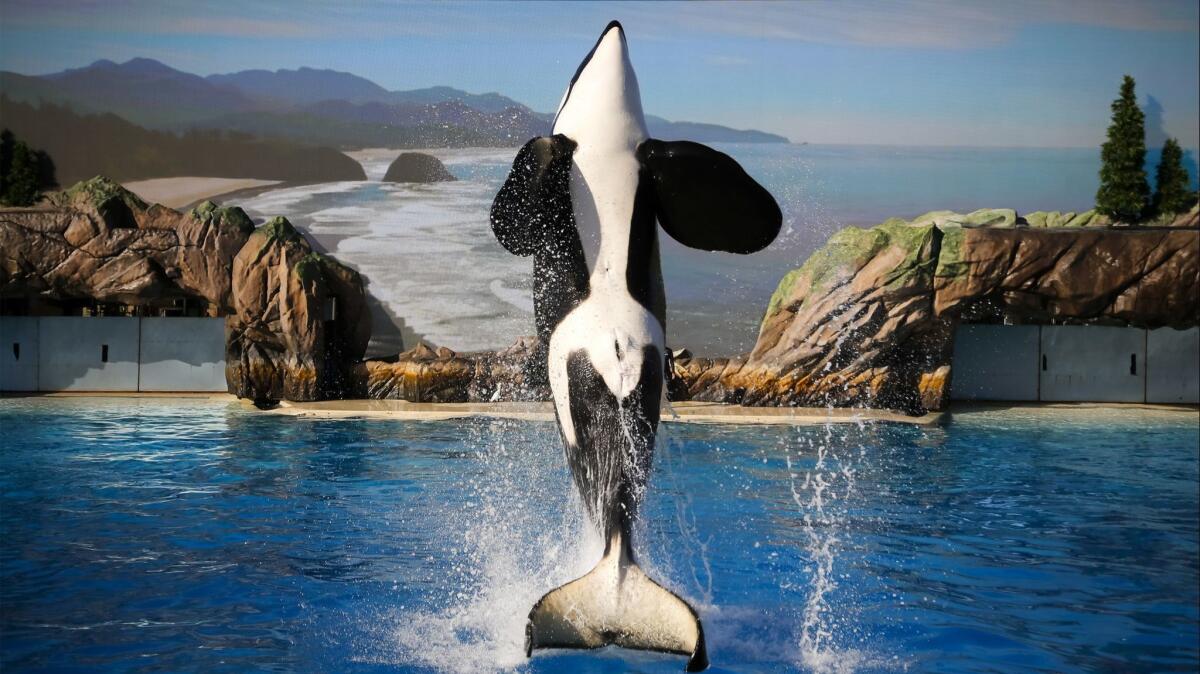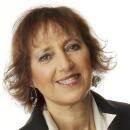Is SeaWorld making a comeback? Attendance jumps, and its stock leaps

- Share via
SeaWorld Entertainment Inc. reported notable gains in attendance and revenue Monday for the second quarter in a row, signaling a possible rebound from years of steep losses in visitation.
Attendance jumped nearly 5% in the quarter that ended June 30, with 290,000 more guests visiting SeaWorld’s 12 parks than in the same quarter last year. And through July, SeaWorld saw 900,000 more guests passing through park turnstiles than in the same period last year, executives reported Monday.
Second-quarter revenue also rose nearly 5% to $391.9 million, up from $373.8 million in the year-earlier quarter.
Investors cheered the news, sending SeaWorld’s stock up 16.8% to close at $24.69.
SeaWorld also said Monday that it has reached an initial settlement with the Securities and Exchange Commission related to possible violations of federal securities law.
The disclosure — which included few details other than it could cost the company an estimated $4 million — stems from a notice the SEC sent to SeaWorld this year, saying its staff was recommending a “civil enforcement action or administrative proceeding be brought against the company.”
SeaWorld has been under investigation by the SEC and the Department of Justice for executives’ disclosures and public statements in August 2014 and earlier about the effect of the anti-captivity documentary “Blackfish” and trading in the company’s securities.
The status of the Justice Department investigation is unknown. SeaWorld also faces a class-action suit accusing it of misleading shareholders about how “Blackfish” — which was critical of the marine parks’ treatment of killer whales — contributed to falling attendance and revenue.
In its disclosure Monday, SeaWorld said the proposed settlement with the enforcement staff of the SEC includes no admission or denial of “potential charges against the company arising out of the previously disclosed SEC investigation.” The settlement, SeaWorld said, is still subject to approval by the commission and there is no guarantee it will be finalized.
Interim Chief Executive John Reilly, who referenced the possible settlement only briefly during the earnings call, attributed the second quarter’s strong results to new pricing strategies, a continued focus on marketing and well-received new attractions, including the recently opened Electric Eel coaster in San Diego.
“We are confident in the direction we are heading, and we are encouraged by the results we are seeing in our business,” Reilly told analysts in a conference call. “Our confidence extends to our long-term view in the significantly improved financial performance we believe this company can deliver in the next few years and beyond.”
The results come on the heels of a strong first quarter, when attendance rose nearly 15% and revenue rose 16.5%.
The second quarter is a more credible reflection of the company’s performance given that it includes the start of summer, when many more of SeaWorld Entertainment’s parks are open.
The two consecutive quarters of gains represent a significant turnaround from years of disappointing financial performance that has dogged the Orlando, Fla., company since the release of “Blackfish.”
The attendance growth also is an improvement over a dismal 2017 for the San Diego and Orlando marine parks, which saw visits fall by double digits, according to a report released this year documenting 2017 attendance at the world’s top amusement parks.
Although the company does not break out performance by park, lease payments that SeaWorld San Diego makes to the city for its Mission Bay location show a marked uptick over last year. The payments, which are tied to SeaWorld admissions and food and beverage sales, rose 17% during the first five months of this year compared with the same period in 2017.
“San Diego is really a reflection of the key strategies and initiatives that we’ve reflected across the portfolio,” Reilly said. “We launched Electric Eel in May and it’s received positive acclaim, and I think the consumers in San Diego are excited about having a high thrill ride there.”
SeaWorld has been working since 2016 to aggressively cut costs, hoping to slash $40 million by the end of this year. Reilly said Monday that the company has reached that goal. SeaWorld is looking to cut an additional $50 million in costs, but Reilly did not identify what that would entail.
Looking ahead, SeaWorld said it expects to realize a goal of as much as $500 million in earnings before interest, taxes, depreciation and amortization by 2020. The calculation is based, in part, on expected average annual attendance growth of 1%. If it succeeds, SeaWorld said the gains would recapture about 25% of the attendance it lost over the last five years.
Unspoken during the earnings call was who will succeed Joel Manby — who left the company in February — as CEO. Reilly, a former park president in San Diego, has been mentioned as a possible candidate.
Weisberg writes for the San Diego Union-Tribune.
UPDATES:
1:45 p.m.: This article was updated with SeaWorld shares’ closing price and with information about a class-action lawsuit.
This article was originally published at 10 a.m.
More to Read
Inside the business of entertainment
The Wide Shot brings you news, analysis and insights on everything from streaming wars to production — and what it all means for the future.
You may occasionally receive promotional content from the Los Angeles Times.











